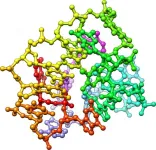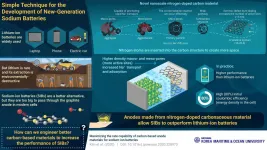INFORMATION:
Graphene Flagship study predicts increased market penetration by 2025
Graphene Flagship experts identify key opportunities in graphene commercialization after a comprehensive three-year analysis of production methods and potential applications
2021-01-25
(Press-News.org) What happened to the promised applications of graphene and related materials? Thanks to initiatives like the European Union's Graphene Flagship and heavy investments by leading industries, graphene manufacturing is mature enough to produce prototypes and some real-life niche applications. Now, researchers at Graphene Flagship partner The Fraunhofer Institute for Systems and Innovation Research (ISI) in Karlsruhe, Germany, have published two papers that roadmap the expected future mass introduction of graphene and related materials in the market.
Back in 2004, graphene was made by peeling off atomically thin layers from a graphite block. Now, thanks to the advances pioneered by the Graphene Flagship, among others, we can produce high quantities of graphene with a reliable and reproducible quality. Furthermore, the Graphene Flagship has driven the discovery of thousands of layered materials, complementary to graphene in properties and applications, and has spearheaded efforts to standardise the fabrication of graphene to ensure consistency and trustworthiness.
The new publications by Graphene Flagship researchers at Fraunhofer ISI, just issued by IOP Publishing's journal 2D Materials, review the latest outcomes of the Technology and Innovation Roadmap, a process that explores the different pathways towards industrialisation and commercialisation of graphene and related materials. In particular, these articles summarise the impact that graphene and related materials will have transforming the manufacturing process and triggering the emergence of new value chains.
"Our final goal is seeing graphene and related materials fully integrated in day-to-day products and manufacturing," says Henning Döscher from Graphene Flagship partner Fraunhofer ISI, who leads the Graphene Flagship Roadmap Team. "We are continuously analysing scientific and technological advances in the field as well as their capacity to fulfil future industrial needs. Our first Graphene Roadmap Brief articles summarise some of the most exciting results," he adds. "Graphene and related materials add value throughout the value chain, from enhancing and enabling new materials to improving individual components and, eventually, end products." The most immediate applications of graphene, such as composites, inks and coatings are already commercially available, as highlighted by the Graphene Flagship product gallery. The industry will soon be ready to absorb and implement the latest innovations and start manufacturing batteries, solar panels, electronics, photonic and communication devices and medical technologies.
"The market demand for graphene has almost quadrupled in the last two years," explains Thomas Reiss from Graphene Flagship partner Fraunhofer ISI, and co-leader of the roadmap endeavour. "By strengthening standards and creating tailored high-quality materials, we expect to go beyond niche products and applications to broad market penetration by 2025," he adds. "Then, graphene could be incorporated in ubiquitous commodities such as tyres, batteries and electronics."
The dawning decade seems decisive in the road to market of graphene and related materials. "By 2030 we will see if graphene is really as disruptive as silicon or steel," says Döscher. "The Graphene Flagship has already shown that graphene is useful for numerous applications," he adds. "Now, we need to ensure that Europe stays a leader in the field, to ensure we benefit from the economic and societal impact of developing such an innovation."
Alexander Tzalenchuk, Graphene Flagship Leader for Industrialisation, says: "The publication of the Graphene Flagship Roadmap Briefs is a timely and welcome development for industries innovating with graphene and related materials. Improving trust and confidence in graphene-enabled products is a key prerequisite for industrial uptake. Informed by the market analysis and technology assessment of the Graphene Flagship Roadmap, this further contributes to our agenda providing expert validation of the characteristics of graphene and related materials, graphene-enhanced components, devices and systems, by developing consensus-based and accepted international standards."
Kari Hjelt, Head of Innovation of the Graphene Flagship, adds: "We see a strong increased interest in graphene by several branches of industry as witnessed by the eleven Spearhead Projects of the Graphene Flagship, all led by industry partners. The first mass applications pave the way to emerging high value-added areas in electronics and biomedical applications. In the near future, we will start to witness the transformative power of graphene in many industries. The updates from the Technology and Innovation Roadmap team sheds light on the road ahead for both research and industrial communities alike."
ELSE PRESS RELEASES FROM THIS DATE:
New advances in the detection of bias in face recognition algorithms
2021-01-25
A team from the Computer Vision Center (CVC) and the University of Barcelona has published the results of a study that evaluates the accuracy and bias in gender and skin colour of automatic face recognition algorithms tested with real world data. Although the top solutions exceed the 99.9% of accuracy, researchers have detected some groups that show higher false positive or false negative rates.
Face recognition has been routinely used by both private and governmental organizations worldwide. Automatic face recognition can be used for legitimate and beneficial purposes (e.g. to improve security) but at the same time its power and ubiquity increases a potential negative ...
Microstructured optical fibers find their 3D-printed groove
2021-01-25
Small-scale optical devices capable of using photons for high-speed information processing can be fabricated with unprecedented ease and precision using an additive manufacturing process developed at KAUST.
Fiber optics are conventionally produced by drawing thin filaments out of molten silica glass down to microscale dimensions. By infusing these fibers with long narrow hollow channels, a new class of optical devices termed "photonic crystal fibers" were introduced. The periodic arrangement of air holes in these photonic crystal fibers act like near-perfect mirrors, allowing trapping and long propagation of light in their central core.
"Photonic crystal fibers allow you to confine light in very tight spaces, increasing the optical ...
Identification of Oligo-DNA that promotes skeletal muscle differentiation
2021-01-25
Skeletal muscle is the largest tissue in the human body and is responsible not only for locomotion but for energy metabolism and heat production. Age-related muscle atrophy reduces motor function and contributes to the need for nursing care. In addition, muscle atrophy associated with various chronic diseases is known to be a risk factor for life expectancy. Myoblasts, the progenitor cells of muscle, play an important role in maintaining muscle homeostasis. However, it has been reported that the differentiation ability of myoblasts decreases with age and disease, and this is thought to be one of the causes of muscle atrophy. In order to prevent or treat muscle atrophy, a research team led by Assistant Professor Tomohide Takaya of Shinshu University, Faculty of Agriculture studied ...
Optimal information about the invisible
2021-01-25
Laser beams can be used to precisely measure an object's position or velocity. Normally, however, a clear, unobstructed view of this object is required - and this prerequisite is not always satisfied. In biomedicine, for example, structures are examined, which are embedded in an irregular, complicated environment. There, the laser beam is deflected, scattered and refracted, often making it impossible to obtain useful data from the measurement.
However, Utrecht University (Netherlands) and TU Wien (Vienna, Austria) have now been able to show that meaningful results can be obtained even in such complicated environments. Indeed, there is a way to specifically modify ...
Street trees close to the home may reduce the risk of depression
2021-01-25
Depression, especially in urban areas, is on the rise, now more than ever. Mental health outcomes are influenced by, among other things, the type of environment where one lives. Former studies show that urban greenspace has a positive benefit on people experiencing mental ill health, but most of these studies used self-reported measures, which makes it difficult to compare the results and generalise conclusions on the effects of urban greenspace on mental health.
An interdisciplinary research team of UFZ, iDiv and Leipzig University tried to improve this issue by involving an objective indicator: prescriptions of antidepressants. To find out whether a specific type of 'everyday' green space - street trees dotting the neighbourhood sidewalks ...
New galaxy sheds light on how stars form
2021-01-25
A lot is known about galaxies. We know, for instance, that the stars within them are shaped from a blend of old star dust and molecules suspended in gas. What remains a mystery, however, is the process that leads to these simple elements being pulled together to form a new star.
But now an international team of scientists, including astrophysicists from the University of Bath in the UK and the National Astronomical Observatory (OAN) in Madrid, Spain have taken a significant step towards understanding how a galaxy's gaseous content becomes organised into a new generation of stars.
Their findings have important implications for our understanding of how stars formed during the early days of the universe, when galaxy collisions were frequent and dramatic, and star and galaxy formation ...
Preventing loneliness in children of depressed mothers may reduce adolescent suicidality
2021-01-25
Children of mothers experiencing depressive symptoms are more at risk, as adolescents, of experiencing suicidal thoughts and attempting suicide.
New research suggests that this link may be explained by loneliness, potentially opening new ways for youth suicide prevention.
The study - by the universities of Exeter, Montréal, Laval and McGill - used data from more than 1,600 families from the Québec Longitudinal Study of Child Development, a representative sample of new-borns in Quebec followed from birth to 20 years of age.
Mothers were asked about depressive symptoms (such as sadness and losing interest ...
Charged up: revolutionizing rechargeable sodium-ion batteries with 'doped' carbon anodes
2021-01-25
As the world becomes aware of the imminent environmental crisis, scientists have begun a search for sustainable energy sources. Rechargeable batteries like lithium-ion batteries are seeing a popularity surge, concurrent with production of "greener" technologies such as electric propulsion ships (which are being developed to meet the environmental regulations by the International Maritime Organization) and other electric vehicles. But, lithium is rare and difficult to distribute, putting its sustainability in doubt while also risking sharp increases in cost. Researchers have thus turned ...
GEFS: Searching beyond seismology for earthquake precursors
2021-01-25
To predict when earthquakes are likely to occur, seismologists often use statistics to monitor how clusters of seismic activity evolve over time. However, this approach often fails to anticipate the time and magnitude of large-scale earthquakes, leading to dangerous oversights in current early-warning systems. For decades, studies outside the seismology field have proposed that these major, potentially devastating seismic events are connected to a range of non-seismic phenomena - which can be observed days or even weeks before these large earthquakes occur. So far, however, this idea hasn't caught on in the wider scientific community. In this special issue, EPJ Special Topics proposes the Global Earthquake Forecasting System (GEFS): the first collaborative initiative ...
Scientists show impact of human activity on bird species
2021-01-25
Scientists have shown where bird species would exist in the absence of human activity under research that could provide a new approach to setting conservation priorities.
A study by Durham University, UK, in collaboration with the Royal Society for the Protection of Birds (RSPB), investigated how human activities such as agriculture, deforestation, and the drainage of wetlands have shaped where bird species are found in Great Britain today.
Researchers used data on the geographical distributions of bird species alongside simulation models to predict where bird species would exist today if the effects of human activities on the landscape were removed.
In this scenario there were winners ...
LAST 30 PRESS RELEASES:
Numbers in our sights affect how we perceive space
SIMJ announces global collaborative book project in commemoration of its 75th anniversary
Air pollution exposure and birth weight
Obstructive sleep apnea risk and mental health conditions among older adults
How talking slows eye movements behind the wheel
The Ceramic Society of Japan’s Oxoate Ceramics Research Association launches new international book project
Heart-brain connection: international study reveals the role of the vagus nerve in keeping the heart young
Researchers identify Rb1 as a predictive biomarker for a new therapeutic strategy in some breast cancers
Survey reveals ethical gaps slowing AI adoption in pediatric surgery
Stimulant ADHD medications work differently than thought
AI overestimates how smart people are, according to HSE economists
HSE researchers create genome-wide map of quadruplexes
Scientists boost cell "powerhouses" to burn more calories
Automatic label checking: The missing step in making reliable medical AI
Low daily alcohol intake linked to 50% heightened mouth cancer risk in India
American Meteorological Society announces Rick Spinrad as 2026 President-Elect
Biomass-based carbon capture spotlighted in newly released global climate webinar recording
Illuminating invisible nano pollutants: advanced bioimaging tracks the full journey of emerging nanoscale contaminants in living systems
How does age affect recovery from spinal cord injury?
Novel AI tool offers prognosis for patients with head and neck cancer
Fathers’ microplastic exposure tied to their children’s metabolic problems
Research validates laboratory model for studying high-grade serous ovarian cancer
SIR 2026 delivers transformative breakthroughs in minimally invasive medicine to improve patient care
Stem Cell Reports most downloaded papers of 2025 highlight the breadth and impact of stem cell research
Oxford-led study estimates NHS spends around 3% of its primary and secondary care budget on the health impacts of heat and cold in England
A researcher’s long quest leads to a smart composite breakthrough
Urban wild bees act as “microbial sensors” of city health.
New study finds where you live affects recovery after a hip fracture
Forecasting the impact of fully automated vehicle adoption on US road traffic injuries
Alcohol-related hospitalizations from 2016 to 2022
[Press-News.org] Graphene Flagship study predicts increased market penetration by 2025Graphene Flagship experts identify key opportunities in graphene commercialization after a comprehensive three-year analysis of production methods and potential applications





